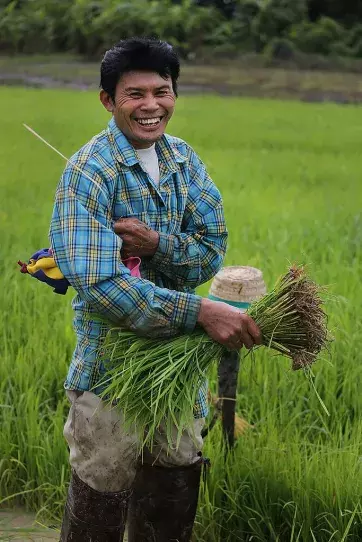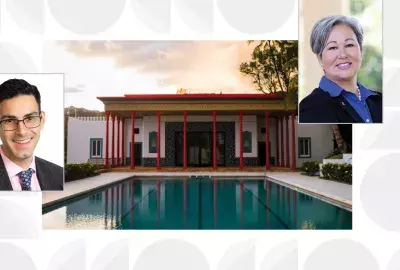Error message

By Jefferson M. Fox, Arunee Promkhambut, and Phanwin Yokying
HONOLULU (3 July 2020)—In Southeast Asia, rice farmers are dealing with one of the worst droughts in recent history, and now they also face substantial challenges created by the COVID-19 pandemic. At the same time, global demand for food stockpiles is pushing rice prices for consumers to levels not seen since the 2008 global economic crisis.
Most rice exports from Asia
About three-quarters of worldwide rice exports originate from Asia, with total shipments in 2019 valued at around US$16.4 billion. Rice traders in India, the world’s largest rice exporter, suspended exports for three weeks in early April amid a nationwide lockdown. Even after reopening, labor shortages and logistic disruptions have hampered the delivery of rice contracts. Myanmar also stopped issuing rice export licenses in April, while Vietnam halted the exports of most varieties of rice from mid-March until early May.
Thailand, the world’s second-largest exporter, has continued to export rice as usual. The Thai government announced that sufficient rice had been produced to meet its annual export target—normally around 10 million tons—on top of a similar amount earmarked for domestic consumption. At the beginning of 2020, Thailand’s rice export prices were depressed, but the market turned around completely with the coronavirus outbreak, and prices increased by more than 25 percent.
Cambodia, a much smaller rice producer, saw rice exports skyrocket by 42 percent over the first five months of the year. Farmers in the Mekong region of Vietnam reportedly harvested a record-breaking crop in February 2020, just in time to benefit from the price hikes associated with the pandemic.
On the demand side, China, the world’s biggest rice consumer, saw surging demand in the first quarter of 2020 that increased rice imports by 60 percent. Other rice importers in the region—including Indonesia, Malaysia, and the Philippines—have stockpiled substantial supplies to supplement domestic production by importing from Thailand and Cambodia, and increasingly from India.
Over the past several decades, rice farmers across the region have experienced growing labor shortages as working-age adults migrated to nearby cities and abroad in search of better jobs. As a result, farmers have increasingly mechanized rice production, switched to higher-yielding varieties, and used more chemical fertilizers, pesticides, and herbicides, all of which require greater capital inputs.
COVID-19 adds to an already stressful situation
To this already stressful situation, COVID-19 has added an additional level of uncertainty for both farmers and farm workers. For migrant workers, the pandemic has caused unprecedented job losses and has interrupted remittance flows. In Thailand, while only 4 percent of migrants reportedly returned home, international remittances decreased from $361 billion in March 2020 to $286 billion in April, a loss of 21 percent. Across the region, locals who live on farms but have other jobs have also lost income.
In a June 2020 phone survey of 30 Thai farm households, more than 80 percent reported planting this year’s rainy season crop (April to June) as usual. Those who did not plant said they were constrained by drought conditions, not COVID-19, but more than 65 percent of farmers reported problems with purchasing agricultural inputs, such as seeds and fertilizers. Limited access to credit and other financial barriers were also mentioned.
Assistance has been spotty. The Thai government is providing farmers with 5,000 Baht (US$162) per month from May through July 2020. The farmers surveyed reported that they are using this money to maintain rice production. In Cambodia, the government also offered some debt relief to farmers. In Vietnam, private businessmen set up dispensing machines to provide a daily supply of rice to poor households, thus supporting both rice farmers and the unemployed. In Myanmar and Laos, newspaper reports suggest that farmers have been unable to raise money for planting rice because government loans have paused and microfinancing institutions have suspended operations.
Because of the 2019–2020 drought, farmers in northern Laos have not even produced enough rice for home consumption. The Food and Agriculture Organization (FAO) reports that 80 percent of farmers in some provinces ran out of rice in April and need to bridge another seven months before the next harvest. COVID-19 has made it difficult for them to find off-farm employment to earn money for food, and some have reportedly been forced to forage for food in the forest.
While food is still available in the region as a whole, COVID-19 has caused food insecurity in many urban areas as incomes dropped during the shutdowns. Residents of Bangkok, Chiang Mai, Yangon, and other Southeast Asian cities who have lost work can no longer afford to pay rent or buy food. Taxi drivers, street vendors, day laborers, elderly citizens, and others now reportedly rely on volunteer food banks for survival. The FAO has warned that a protracted pandemic will further disrupt food supply chains, affecting everyone from consumers, to farmers, to middlemen and retailers.
In some parts of the region, access to clean water is also becoming problematic, both because of the drought and because of the emphasis on hand washing in national COVID-19 awareness campaigns. In Cambodia and Laos, reports suggest that many in rural areas do not have enough clean water for drinking and sanitation. The picture in some densely populated urban areas is equally grim. The Director-General of Phnom Penh Water Supply Authority estimates that many districts in Phnom Penh are likely to suffer clean water shortages for another three years.
Lockdowns to contain COVID-19 have also exposed farmers in some areas to unprincipled land grabs. News reports from eastern Cambodia say that a Vietnamese rubber company, Hoang Anh Gia Lai (HAGL), illegally cleared swaths of land in Ratanakiri Province that belonged to indigenous farming communities. Despite pledges to return the land to local farmers, the company bulldozed sacred sites, burial grounds, traditional hunting areas, farm lands, wetlands and old-growth forests, while local residents sheltered at home due to COVID-19.
In Southeast Asia, COVID 19 has affected rice farming in many ways including security of land tenure and access to credit, capital inputs, remittance income, and safe food and water. During emergencies such as the 2019 drought and the COVID-19 pandemic, farmers need assistance, either from the government or private philanthropy. Thailand and Vietnam, the wealthier countries in the region, have provided farmers with basic assistance. Farmers in Myanmar, Laos, and Cambodia are struggling.
###
Download a PDF version of this Wire article.
Jefferson M. Fox ([email protected]) is a Senior Fellow at the East -West Center. Arunee Promkhambut ([email protected]) is a lecturer at Khon Kaen University. Phanwin Yokying ([email protected]) is a Fellow at the East-West Center.
The East-West Wire is a news, commentary, and analysis service provided by the East-West Center in Honolulu. All or any part of the Wire content may be used by media with attribution to the East-West Center or the person quoted. To receive Wire articles via email, subscribe here. For links to all East-West Center media programs, fellowships and services, see EastWestCenter.org/Journalists.
The full list of East-West Wires produced by the Research Program is available on the East-West Center website at EastWestCenter.org/Research-Wire. For more on the East-West Center Research Program, see EastWestCenter.org/Research.
The East-West Center promotes better relations and understanding among the people and nations of the United States, Asia, and the Pacific through cooperative study, research, and dialogue.
Series editors:
Derek Ferrar
[email protected]
Sidney B. Westley
[email protected]
Photo: A farmer harvests rice in Ban San Ka Wan, Thailand. Credit: Taylor Weidman/Getty Images.
By Jefferson M. Fox, Arunee Promkhambut, and Phanwin Yokying
HONOLULU (3 July 2020)—In Southeast Asia, rice farmers are dealing with one of the worst droughts in recent history, and now they also face substantial challenges created by the COVID-19 pandemic. At the same time, global demand for food stockpiles is pushing rice prices for consumers to levels not seen since the 2008 global economic crisis.
Most rice exports from Asia
About three-quarters of worldwide rice exports originate from Asia, with total shipments in 2019 valued at around US$16.4 billion. Rice traders in India, the world’s largest rice exporter, suspended exports for three weeks in early April amid a nationwide lockdown. Even after reopening, labor shortages and logistic disruptions have hampered the delivery of rice contracts. Myanmar also stopped issuing rice export licenses in April, while Vietnam halted the exports of most varieties of rice from mid-March until early May.
Thailand, the world’s second-largest exporter, has continued to export rice as usual. The Thai government announced that sufficient rice had been produced to meet its annual export target—normally around 10 million tons—on top of a similar amount earmarked for domestic consumption. At the beginning of 2020, Thailand’s rice export prices were depressed, but the market turned around completely with the coronavirus outbreak, and prices increased by more than 25 percent.
Cambodia, a much smaller rice producer, saw rice exports skyrocket by 42 percent over the first five months of the year. Farmers in the Mekong region of Vietnam reportedly harvested a record-breaking crop in February 2020, just in time to benefit from the price hikes associated with the pandemic.
On the demand side, China, the world’s biggest rice consumer, saw surging demand in the first quarter of 2020 that increased rice imports by 60 percent. Other rice importers in the region—including Indonesia, Malaysia, and the Philippines—have stockpiled substantial supplies to supplement domestic production by importing from Thailand and Cambodia, and increasingly from India.
Over the past several decades, rice farmers across the region have experienced growing labor shortages as working-age adults migrated to nearby cities and abroad in search of better jobs. As a result, farmers have increasingly mechanized rice production, switched to higher-yielding varieties, and used more chemical fertilizers, pesticides, and herbicides, all of which require greater capital inputs.
COVID-19 adds to an already stressful situation
To this already stressful situation, COVID-19 has added an additional level of uncertainty for both farmers and farm workers. For migrant workers, the pandemic has caused unprecedented job losses and has interrupted remittance flows. In Thailand, while only 4 percent of migrants reportedly returned home, international remittances decreased from $361 billion in March 2020 to $286 billion in April, a loss of 21 percent. Across the region, locals who live on farms but have other jobs have also lost income.
In a June 2020 phone survey of 30 Thai farm households, more than 80 percent reported planting this year’s rainy season crop (April to June) as usual. Those who did not plant said they were constrained by drought conditions, not COVID-19, but more than 65 percent of farmers reported problems with purchasing agricultural inputs, such as seeds and fertilizers. Limited access to credit and other financial barriers were also mentioned.
Assistance has been spotty. The Thai government is providing farmers with 5,000 Baht (US$162) per month from May through July 2020. The farmers surveyed reported that they are using this money to maintain rice production. In Cambodia, the government also offered some debt relief to farmers. In Vietnam, private businessmen set up dispensing machines to provide a daily supply of rice to poor households, thus supporting both rice farmers and the unemployed. In Myanmar and Laos, newspaper reports suggest that farmers have been unable to raise money for planting rice because government loans have paused and microfinancing institutions have suspended operations.
Because of the 2019–2020 drought, farmers in northern Laos have not even produced enough rice for home consumption. The Food and Agriculture Organization (FAO) reports that 80 percent of farmers in some provinces ran out of rice in April and need to bridge another seven months before the next harvest. COVID-19 has made it difficult for them to find off-farm employment to earn money for food, and some have reportedly been forced to forage for food in the forest.
While food is still available in the region as a whole, COVID-19 has caused food insecurity in many urban areas as incomes dropped during the shutdowns. Residents of Bangkok, Chiang Mai, Yangon, and other Southeast Asian cities who have lost work can no longer afford to pay rent or buy food. Taxi drivers, street vendors, day laborers, elderly citizens, and others now reportedly rely on volunteer food banks for survival. The FAO has warned that a protracted pandemic will further disrupt food supply chains, affecting everyone from consumers, to farmers, to middlemen and retailers.
In some parts of the region, access to clean water is also becoming problematic, both because of the drought and because of the emphasis on hand washing in national COVID-19 awareness campaigns. In Cambodia and Laos, reports suggest that many in rural areas do not have enough clean water for drinking and sanitation. The picture in some densely populated urban areas is equally grim. The Director-General of Phnom Penh Water Supply Authority estimates that many districts in Phnom Penh are likely to suffer clean water shortages for another three years.
Lockdowns to contain COVID-19 have also exposed farmers in some areas to unprincipled land grabs. News reports from eastern Cambodia say that a Vietnamese rubber company, Hoang Anh Gia Lai (HAGL), illegally cleared swaths of land in Ratanakiri Province that belonged to indigenous farming communities. Despite pledges to return the land to local farmers, the company bulldozed sacred sites, burial grounds, traditional hunting areas, farm lands, wetlands and old-growth forests, while local residents sheltered at home due to COVID-19.
In Southeast Asia, COVID 19 has affected rice farming in many ways including security of land tenure and access to credit, capital inputs, remittance income, and safe food and water. During emergencies such as the 2019 drought and the COVID-19 pandemic, farmers need assistance, either from the government or private philanthropy. Thailand and Vietnam, the wealthier countries in the region, have provided farmers with basic assistance. Farmers in Myanmar, Laos, and Cambodia are struggling.
###
Download a PDF version of this Wire article.
Jefferson M. Fox ([email protected]) is a Senior Fellow at the East -West Center. Arunee Promkhambut ([email protected]) is a lecturer at Khon Kaen University. Phanwin Yokying ([email protected]) is a Fellow at the East-West Center.
The East-West Wire is a news, commentary, and analysis service provided by the East-West Center in Honolulu. All or any part of the Wire content may be used by media with attribution to the East-West Center or the person quoted. To receive Wire articles via email, subscribe here. For links to all East-West Center media programs, fellowships and services, see EastWestCenter.org/Journalists.
The full list of East-West Wires produced by the Research Program is available on the East-West Center website at EastWestCenter.org/Research-Wire. For more on the East-West Center Research Program, see EastWestCenter.org/Research.
The East-West Center promotes better relations and understanding among the people and nations of the United States, Asia, and the Pacific through cooperative study, research, and dialogue.
Series editors:
Derek Ferrar
[email protected]
Sidney B. Westley
[email protected]
Photo: A farmer harvests rice in Ban San Ka Wan, Thailand. Credit: Taylor Weidman/Getty Images.
East-West Wire
News, Commentary, and Analysis
The East-West Wire is a news, commentary, and analysis service provided by the East-West Center in Honolulu. Any part or all of the Wire content may be used by media with attribution to the East-West Center or the person quoted. To receive East-West Center Wire media releases via email, subscribe here.
For links to all East-West Center media programs, fellowships and services, see www.eastwestcenter.org/journalists.







